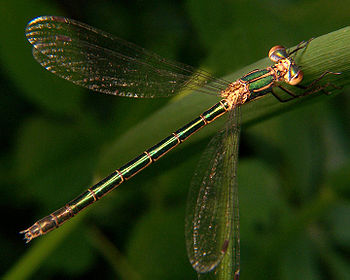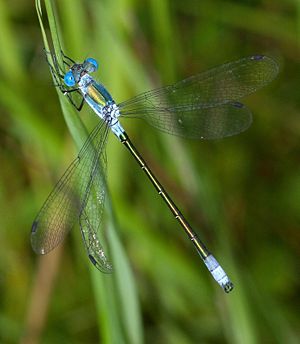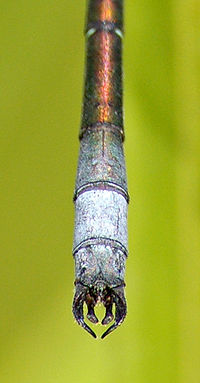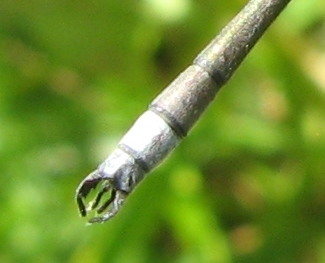
Lestes dryas
Encyclopedia
Lestes dryas is a species of damselfly
which is found across Europe, Asia and North America. In North America it is known as the Emerald Spreadwing and this name is becoming more widely used in Europe. In Britain
, it is very rare so its common name
is the Scarce Emerald Damselfly. An alternate name in Ireland is the Turlough Spreadwing.
L. dryas can tolerate extreme conditions that few other dragonflies can survive.
genus both sexes of L. dryas have largely metallic green bodies with a bronze iridescence
. They usually rest with their wings half spread. L.dryas is very similar in appearance to the Emerald Damselfly L. sponsa
and care must be taken to tell the two species apart.
The male has blue eyes. Powder blue pruinescence
develops on the front and end of the abdomen
, the pronotum and the sides of the thorax. However all Lestes are very similar in appearance and it is the shape and colour of the anal appendage that is characteristic. The anal appendages in L. dryas and L. sponsa
are black whilst in the other European Lestes they are white or light coloured. L. dryas and L. sponsa
have slightly different shaped appendages as show in the photographs.
The female has a more robust abdomen than the male. She has no blue colouration on her body and has brown eyes. Females have beige underparts.

.
and in a few inland lakes in Norfolk and Ireland
.
 Adults fly from April in the south of its range to late May in the north but are on the wing mostly in July and August. They tend to live in dense vegetation and rarely fly over open water, staying near the margins of the pond or lake.
Adults fly from April in the south of its range to late May in the north but are on the wing mostly in July and August. They tend to live in dense vegetation and rarely fly over open water, staying near the margins of the pond or lake.
They mate in the normal damselfly manner by forming the wheel position and after copulation the male stays in tandem, guarding the female while she lays her eggs.
Elongated eggs are laid, usually above water, into plant stems, such as rushes, which are covered as water levels rise in winter. The eggs develop for a few week when, in response to environmental conditions the rate of development slows down and the eggs are said to be in diapause
. In this state the eggs overwinter. The eggs hatch in spring and give rise to the prolarval stage. This is a specialised short lived stage often lasting only minutes. The prolarva has no limbs and cannot feed but it can move by jumping or wriggling and if a prolarva is not in water when it hatches it will move about until water is found. Once in water the prolarva moult to the second stadia stage. The larvae are active and actively hunt prey leading to rapid larval growth. The larvae moult from one stadia to the next until growth is complete; in dragonflies the larval stages are the only stages where growth occurs. The number of stadia is not fixed and in good conditions the last larval stage, called F-0 can be reached in as little as 8 weeks. The newly emerged adults are not able to breed until a period of sexual maturation occurs and it is during this period that the blue pruinescence
develops.
Damselfly
Damselflies are insects in the order Odonata. Damselflies are similar to dragonflies, but the adults can be distinguished by the fact that the wings of most damselflies are held along, and parallel to, the body when at rest...
which is found across Europe, Asia and North America. In North America it is known as the Emerald Spreadwing and this name is becoming more widely used in Europe. In Britain
Great Britain
Great Britain or Britain is an island situated to the northwest of Continental Europe. It is the ninth largest island in the world, and the largest European island, as well as the largest of the British Isles...
, it is very rare so its common name
Common name
A common name of a taxon or organism is a name in general use within a community; it is often contrasted with the scientific name for the same organism...
is the Scarce Emerald Damselfly. An alternate name in Ireland is the Turlough Spreadwing.
L. dryas can tolerate extreme conditions that few other dragonflies can survive.
Identification
Like the other members of the LestesLestes
Lestes is a genus of damselfly in family Lestidae. The family hold their wings at about 45 degrees to the body when resting. This distinguishes them from most other species of damselflies which hold the wings along, and parallel to, the body when at rest....
genus both sexes of L. dryas have largely metallic green bodies with a bronze iridescence
Iridescence
Iridescence is generally known as the property of certain surfaces which appear to change color as the angle of view or the angle of illumination changes...
. They usually rest with their wings half spread. L.dryas is very similar in appearance to the Emerald Damselfly L. sponsa
Lestes sponsa
Lestes sponsa, is a damselfly, with a wide Palaeartic distribution. It is known commonly as the Emerald Damselfly or Common Spreadwing. Both males and females have a metallic green colour and when resting its wings are usually half opened....
and care must be taken to tell the two species apart.
The male has blue eyes. Powder blue pruinescence
Pruinescence
Pruinescence, or pruinosity, is a "bloom" caused by pigment on top of an insect's cuticle that covers up the underlying coloration, giving a dusty or frosted appearance. The pruinescence is commonly white to pale blue in color, but can also be gray, pink, purple, or red; these colors may be...
develops on the front and end of the abdomen
Abdomen
In vertebrates such as mammals the abdomen constitutes the part of the body between the thorax and pelvis. The region enclosed by the abdomen is termed the abdominal cavity...
, the pronotum and the sides of the thorax. However all Lestes are very similar in appearance and it is the shape and colour of the anal appendage that is characteristic. The anal appendages in L. dryas and L. sponsa
Lestes sponsa
Lestes sponsa, is a damselfly, with a wide Palaeartic distribution. It is known commonly as the Emerald Damselfly or Common Spreadwing. Both males and females have a metallic green colour and when resting its wings are usually half opened....
are black whilst in the other European Lestes they are white or light coloured. L. dryas and L. sponsa
Lestes sponsa
Lestes sponsa, is a damselfly, with a wide Palaeartic distribution. It is known commonly as the Emerald Damselfly or Common Spreadwing. Both males and females have a metallic green colour and when resting its wings are usually half opened....
have slightly different shaped appendages as show in the photographs.
 |
 |
The female has a more robust abdomen than the male. She has no blue colouration on her body and has brown eyes. Females have beige underparts.

Habitat and distribution
L. dryas is found in a band around the world from 400 north to 600 north across central Europe and Asia from France to the Pacific and across north America. L. dryas is the only Lestes that occurs in Europe and in north America. Around the Mediterranean it is found at altitude. It is found in still, shallow water in well vegetated ditches, ponds, bogs and lakes. It can be found near the coast in slightly brackish water. It is widespread in Europe but is never as common as L. sponsaLestes sponsa
Lestes sponsa, is a damselfly, with a wide Palaeartic distribution. It is known commonly as the Emerald Damselfly or Common Spreadwing. Both males and females have a metallic green colour and when resting its wings are usually half opened....
.
Population in Britain
It was believed to be extinct in Britain before being rediscovered in 1983. Since then it has been found at several sites in south-east England. They breed mainly round the Thames estuaryThames Estuary
The Thames Mouth is the estuary in which the River Thames meets the waters of the North Sea.It is not easy to define the limits of the estuary, although physically the head of Sea Reach, near Canvey Island on the Essex shore is probably the western boundary...
and in a few inland lakes in Norfolk and Ireland
Ireland
Ireland is an island to the northwest of continental Europe. It is the third-largest island in Europe and the twentieth-largest island on Earth...
.
Behaviour

They mate in the normal damselfly manner by forming the wheel position and after copulation the male stays in tandem, guarding the female while she lays her eggs.
Elongated eggs are laid, usually above water, into plant stems, such as rushes, which are covered as water levels rise in winter. The eggs develop for a few week when, in response to environmental conditions the rate of development slows down and the eggs are said to be in diapause
Diapause
Diapause is the delay in development in response to regularly and recurring periods of adverse environmental conditions. It is considered to be a physiological state of dormancy with very specific initiating and inhibiting conditions...
. In this state the eggs overwinter. The eggs hatch in spring and give rise to the prolarval stage. This is a specialised short lived stage often lasting only minutes. The prolarva has no limbs and cannot feed but it can move by jumping or wriggling and if a prolarva is not in water when it hatches it will move about until water is found. Once in water the prolarva moult to the second stadia stage. The larvae are active and actively hunt prey leading to rapid larval growth. The larvae moult from one stadia to the next until growth is complete; in dragonflies the larval stages are the only stages where growth occurs. The number of stadia is not fixed and in good conditions the last larval stage, called F-0 can be reached in as little as 8 weeks. The newly emerged adults are not able to breed until a period of sexual maturation occurs and it is during this period that the blue pruinescence
Pruinescence
Pruinescence, or pruinosity, is a "bloom" caused by pigment on top of an insect's cuticle that covers up the underlying coloration, giving a dusty or frosted appearance. The pruinescence is commonly white to pale blue in color, but can also be gray, pink, purple, or red; these colors may be...
develops.
See also
- List of damselflies of the world (Lestidae)
- List of Odonata species of Great Britain

